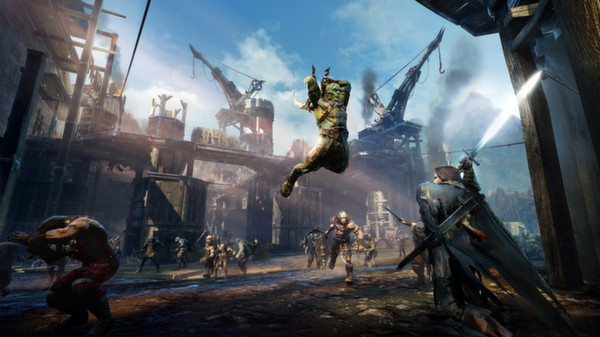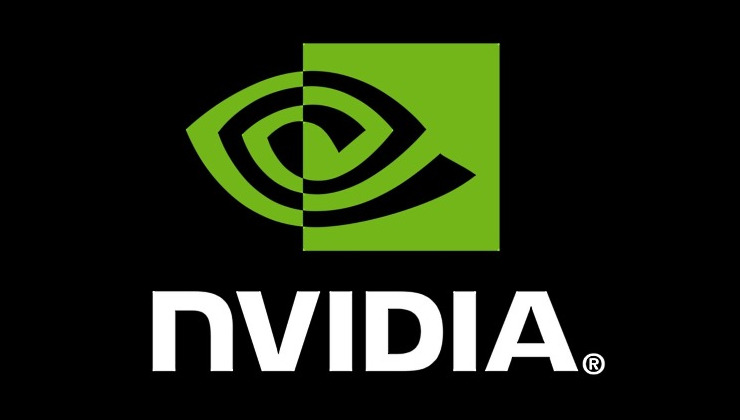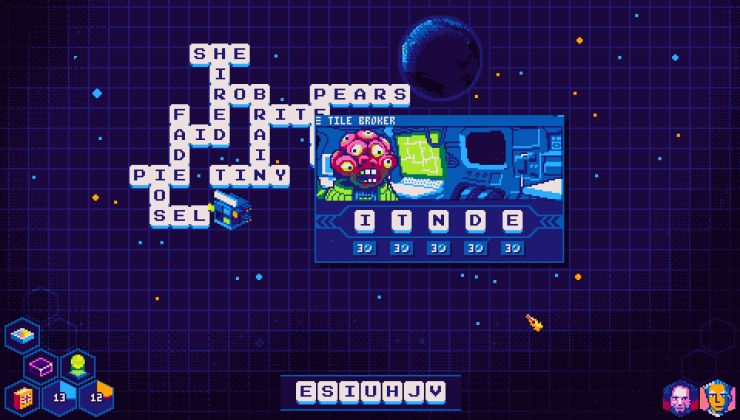
We decided it was time to plug Shadow of Mordor again, only this time myself and Samsai have conducted some benchmarks across four different Nvidia GPU’s.
We do all this simply because we love what we do, and thanks to the support from our fans. No need to tip us.
One thing I discovered recently, is that a driver update forced “Sync to VBlank” on in the Nvidia control panel. I suggest you take a look as well, as others I have spoken to also had their setting turned on.
This is easily the most graphically heavy game that Linux has right now, and not because of optimizations being needed, but the graphical options are plentiful and it looks gorgeous. Well, as gorgeous as Mordor looks anyway for a rather bleak setting full of Uruk.
We both have low and higher end cards, with myself having a higher end CPU and Samsai having a lower end CPU, so these benchmarks should give a good indicator at the performance you can currently expect on Linux.
These tests are using the presets as they are, so we haven’t tweaked any other settings. All tests are run at 1920x1080 resolution.
It’s worth noting that for Ultra, you really need around 6GB or more VRAM, as it uses a lot. Luckily, the benchmarks don’t use up too much, so three of our cards were able to go through the benchmark on Ultra, but it killed my 560 Ti. Note that the HD Content texture pack was not used for these benchmarks.

As you can see, a GTX 970 can run the game at a quite consistent framerate with the averages always above the 60 FPS line. The 3.5GB (4GB technically, but the last 500MB is slow) of VRAM is a quite reasonable amount for this benchmark and the performance drop-off is actually fairly small.
Note: This shows my 970 performing better than the 980 Ti and Titan X tested over at Phoronix, so his benchmark is very odd.

GTX 760 can also handle the game reasonably well up until Very High. The average framerates are a little bit shy from 60 FPS but they stay in the 50-60 FPS range in Medium to Very High. For the game in question this is very much an acceptable framerate. On Ultra the performance drops rapidly and this is most likely due to the VRAM. The 760 comes with 2GB of VRAM which is a lot lower than the game recommends.

The 560 Ti is technically faster than the 640 mentioned in the system requirements for this game but it’s starting to be outdated at this point. From Low to High the game runs from a little over 40 to little less than 30 FPS. 30 FPS is usually considered the lowest acceptable framerate, though nothing to cheer about. Note that the game crashed on Ultra and the numbers were a little bit twisted there. It’s definitely too much for this card and its 1GB of VRAM.

The GTX 550 Ti is very close to the 640 in terms of performance and is definitely starting to be in the absolute minimum territory. It can only reach 30 FPS at Low and even at Medium the card is starting to perform poorly. After High this poor old card is not able to maintain a framerate that anyone could consider playable. This doesn’t come as too big of a surprise because the card only has 1GB of VRAM which pretty much seals the fate of this card on anything higher than Medium.
The raw data can be found on the next page if you want to see it in pure numerical form.
We hoped you like these tests, and hopefully we can do more as and when more cards become available to us, and when more games support benchmarking modes.
Samsai has ordered an AMD R7 370 4GB, and I will also be looking to get one soon. That way we can cover more ground for you, and our benchmarks will be more interesting.
Some you may have missed, popular articles from the last month:
All posts need to follow our rules. For users logged in: please hit the Report Flag icon on any post that breaks the rules or contains illegal / harmful content. Guest readers can email us for any issues.
You should upgrade to 352.Unfortunately, every post-340 driver [has a regression](https://bugs.launchpad.net/ubuntu/+source/nvidia-graphics-drivers-346/+bug/1455617) that breaks HDMI-out on my machine. :-|
0 Likes
For everyone interested in Windows vs. Linux Benchmarks of this game (don't klick if you're not prepared for bad news):
http://www.phoronix.com/scan.php?page=article&item=mordor-win10-linux&num=1
Here's another test coming to the same result:
https://www.youtube.com/watch?v=89G9qHrjS4A
Seems SOM needs some heavy optimization work.
http://www.phoronix.com/scan.php?page=article&item=mordor-win10-linux&num=1
Here's another test coming to the same result:
https://www.youtube.com/watch?v=89G9qHrjS4A
Seems SOM needs some heavy optimization work.
0 Likes
The game is already able to get pretty high max framerate if you have powerful hardware. The problem is the minimum fps is considerably lower. It's shocking to the eyes if you're slashing orcs at 60 fps and suddenly dip down to 35. If you were already at 40 and dip down to 35, you might not notice as much. If you dip down to 18 or something like that, you're watching a slide show. What it needs is a more stable framerate. A solid 50, for example, would be smoother than fluctuating between 60 and 35, if that makes sense. I'm not advocating for a locked framerate at 30, just that consistency is as important as speed.
0 Likes
Here is a comparison of Ubuntu 15.04 vs Windows 10 x64 Pro:
[http://www.phoronix.com](http://www.phoronix.com/scan.php?page=article&item=mordor-win10-linux&num=2)
Last edited by BOYSSSSS on 6 Aug 2015 at 10:24 am UTC
[http://www.phoronix.com](http://www.phoronix.com/scan.php?page=article&item=mordor-win10-linux&num=2)
Last edited by BOYSSSSS on 6 Aug 2015 at 10:24 am UTC
0 Likes
For everyone interested in Windows vs. Linux Benchmarks of this game (don't klick if you're not prepared for bad news):Those Phoronix benchmarks are completely wrong and that's one of the reasons why we ran our own benchmarks. You can see Liam's 970 beat a 980 Ti so whatever Larabel did was completely wrong. The Windows results might be accurate but Linux most definitely isn't. Take the Phoronix results with a boatload of salt.
http://www.phoronix.com/scan.php?page=article&item=mordor-win10-linux&num=1
Here's another test coming to the same result:
https://www.youtube.com/watch?v=89G9qHrjS4A
Seems SOM needs some heavy optimization work.
4 Likes, Who?
Regardless of the validity of Larabel's test results, you should never be suprised if a port does not perform quite as well as the original.
A porting company can hardly spare the resources to rewrite a game engine from scratch to fully exploit the strenghts of the target platform. There'll almost always be compromises and kludges involved. You've seen the same in ports from consoles to Windows. Arkham Knight being one glaring example.
A porting company can hardly spare the resources to rewrite a game engine from scratch to fully exploit the strenghts of the target platform. There'll almost always be compromises and kludges involved. You've seen the same in ports from consoles to Windows. Arkham Knight being one glaring example.
1 Likes, Who?
For everyone interested in Windows vs. Linux Benchmarks of this game (don't klick if you're not prepared for bad news):Those Phoronix benchmarks are completely wrong and that's one of the reasons why we ran our own benchmarks. You can see Liam's 970 beat a 980 Ti so whatever Larabel did was completely wrong. The Windows results might be accurate but Linux most definitely isn't. Take the Phoronix results with a boatload of salt.
http://www.phoronix.com/scan.php?page=article&item=mordor-win10-linux&num=1
Here's another test coming to the same result:
https://www.youtube.com/watch?v=89G9qHrjS4A
Seems SOM needs some heavy optimization work.
Saying it's "completely wrong" almost implies they lied about it. More than likely, you and Liam must have some configuration settings that make the game run better. It would be helpful for all of us to know what those settings are (on your desktop, drivers and game). Perhaps you can help those of us who are getting numbers similar to Phoronix.
0 Likes
The issue is a 980ti and a Titan X on Phoronix capping out at 65fps, to me that tells me he had Vsync to blank turn on in the Nvidia control panel. You all need to check it, as my 970 which is a lower card than both of them was hitting higher than his benchmark, and that's not right at all. He was also using a much more powerful CPU than us, and running it from an SSD where as we are not. His results should be much better, so seriously do take his results lightly.
Last edited by Liam Dawe on 6 Aug 2015 at 11:33 am UTC
Last edited by Liam Dawe on 6 Aug 2015 at 11:33 am UTC
2 Likes, Who?
Saying it's "completely wrong" almost implies they lied about it. More than likely, you and Liam must have some configuration settings that make the game run better. It would be helpful for all of us to know what those settings are (on your desktop, drivers and game). Perhaps you can help those of us who are getting numbers similar to Phoronix.That's easy. Go to the Nvidia X Server Settings -> OpenGL Settings and disable Sync to VBlank. It was noted in the article that a recent driver update managed to turn that on without asking the user and regardless of previous settings.
0 Likes
Games that are 100% OpenGL (which are unfortunately rare; most cross-platform games on PC seem to be an OpenGL-DirectX hybrid) usually have identical performance across platforms. In other words, we're not going to see performance parity until developers abandon DirectX, and that's probably not going to happen any time soon.Yeah I fully expect the benchmarks to go in Windows' favour nowadays. But it would be interesting to see by how much, and how the gap (eventually) starts to shrink, and at what point in time games start to be of equal or better performance. Cause I think it will happen, it would just be fun to see the graphs over time.To raise the tests even one more level on the interest-bar (imho) you could add benchmark results for Windows running on the same machine.Everything I've heard from various forum posts is that the Windows version performs better across the board, which is typical for any game ported from DirectX to OpenGL.
0 Likes
Comparing my 980ti benchmarks to the phoronix results, it looks like I get 30-40 fps more. I don't know if I have 'vsync to blank' enabled, I thought I did, will check tonight. In-game vsync was definitely disabled. I have a 120Hz monitor though, so maybe that already changes the rates even with vsync.
0 Likes
I have a 120Hz monitor though, so maybe that already changes the rates even with vsync.Well, with everything properly configured, you should be able to get up to 120fps with sync to vblank enabled on a system with a 120Hz display.
0 Likes
Here is mine :
archlinux 64 bits
Lowest Low Medium High Very High Ultra
Average 76.81 71.62 60.27 56.03 53.39 45.66
Max fps 139.38 138.27 138.27 86.04 90.86 67.83
Min fps 37.51 38.85 33.65 30.45 19.18 18.21
Windows 8.1
Lowest Low Medium High Very High Ultra
Average 132.65 123.51 92.3 78.54 71.4 60.38
Max fps 193.55 174.13 132 105.54 101.16 84.53
Min fps 68.43 68.19 48.52 51.97 47.7 42.2
Using archlinux on the nvidia proprietary version 353.20 on i3wm
I've a gigabyte nvidia gtx 770 4GB with an intel i7 i3820 3.6 GHZ , 24GB DDR3 1600Mhz , SSD samsung 840 256GB , 4TB wd Black
*Updated with the windows 8.1 benchmark.
**Updated after some wrong results after setting the video menu to 1920x1200 instead of the default resolution
Also a link with the data with a better format.
https://docs.google.com/spreadsheets/d/1nurl2DNpk85Q893dPCQIKBcmagY-Q8eQlGB_1D8jbQE/edit?usp=sharing
The minimum fps is higher on windows than on linux but the average on linux is not too far away to windows for a recent linux launch.
Last edited by hidekin on 6 Aug 2015 at 8:46 pm UTC
archlinux 64 bits
Lowest Low Medium High Very High Ultra
Average 76.81 71.62 60.27 56.03 53.39 45.66
Max fps 139.38 138.27 138.27 86.04 90.86 67.83
Min fps 37.51 38.85 33.65 30.45 19.18 18.21
Windows 8.1
Lowest Low Medium High Very High Ultra
Average 132.65 123.51 92.3 78.54 71.4 60.38
Max fps 193.55 174.13 132 105.54 101.16 84.53
Min fps 68.43 68.19 48.52 51.97 47.7 42.2
Using archlinux on the nvidia proprietary version 353.20 on i3wm
I've a gigabyte nvidia gtx 770 4GB with an intel i7 i3820 3.6 GHZ , 24GB DDR3 1600Mhz , SSD samsung 840 256GB , 4TB wd Black
*Updated with the windows 8.1 benchmark.
**Updated after some wrong results after setting the video menu to 1920x1200 instead of the default resolution
Also a link with the data with a better format.
https://docs.google.com/spreadsheets/d/1nurl2DNpk85Q893dPCQIKBcmagY-Q8eQlGB_1D8jbQE/edit?usp=sharing
The minimum fps is higher on windows than on linux but the average on linux is not too far away to windows for a recent linux launch.
Last edited by hidekin on 6 Aug 2015 at 8:46 pm UTC
1 Likes, Who?
Games that are 100% OpenGL (which are unfortunately rare; most cross-platform games on PC seem to be an OpenGL-DirectX hybrid) usually have identical performance across platforms. In other words, we're not going to see performance parity until developers abandon DirectX, and that's probably not going to happen any time soon.
Don't forget that the biggest console of the current generation, the PS4, don't use DirectX and supposedly is the lead platform for a lot of games in development now. I would guess that could contribute with pushing things away from DirectX.
1 Likes, Who?
The issue is a 980ti and a Titan X on Phoronix capping out at 65fps, to me that tells me he had Vsync to blank turn on in the Nvidia control panel.At least Michael claims he had vsync disabled in the menu - dunno which menu he was referring to; I guess the in-game-menu though. But who knows...
http://www.phoronix.com/forums/forum/software/linux-gaming/815142-shadow-of-mordor-performance-windows-10-vs-ubuntu-linux?p=815259#post815259
Also we should keep in mind that feral demands a better system setup according to it's requirements. So that should indicate that they're aware about the relatively bad performance.
BTW: In the thread above some people are suspecting bad multithreading as the bottleneck. Looks like there's just one CPU core utilized. It would be nice to know if that's also the case with the windows version.
1 Likes, Who?
you should benchmark the game with this driver 355 its way better
https://launchpad.net/~mamarley/+archive/ubuntu/nvidia
https://launchpad.net/~mamarley/+archive/ubuntu/nvidia
0 Likes
you should benchmark the game with this driver 355 its way betterAccording to the changelog and benchmarks floating around the web 355 should perform more or less equally to 352. No need to upgrade in a hurry if everything works.
https://launchpad.net/~mamarley/+archive/ubuntu/nvidia
0 Likes
Thank you for the results, I'll probably play this on High settings under my GTX 770 SC. Appreciate it.
0 Likes
You all knows, thats users reports SoM runs only on one CPU Core?
And thats INTEL CPU owners.
I have the AMD Phenom II X4 960T unlocked to X6 1600T @ 3,8 GHz and SoM runs on all Cores.
My Systeminfos from Steam:
Processor Information:
Vendor: AuthenticAMD
CPU Family: 0x10
CPU Model: 0xa
CPU Stepping: 0x0
CPU Type: 0x0
Speed: 3799 Mhz
6 logical processors
6 physical processors
HyperThreading: Unsupported
FCMOV: Supported
SSE2: Supported
SSE3: Supported
SSSE3: Unsupported
SSE4a: Supported
SSE41: Unsupported
SSE42: Unsupported
Network Information:
Network Speed:
Operating System Version:
"openSUSE 20150802 (Tumbleweed) (x86_64)" (64 bit)
Kernel Name: Linux
Kernel Version: 4.1.3-7.gce190a8-default
X Server Vendor: The X.Org Foundation
X Server Release: 11702000
X Window Manager: KWin (Plasma 5)
Steam Runtime Version: steam-runtime-release_2015-06-12
Video Card:
Driver: NVIDIA Corporation GeForce GTX 760/PCIe/SSE2
Driver Version: 4.5.0 NVIDIA 352.30
OpenGL Version: 4.5
Desktop Color Depth: 24 bits per pixel
Monitor Refresh Rate: 59 Hz
VendorID: 0x10de
DeviceID: 0x1187
Number of Monitors: 2
Number of Logical Video Cards: 1
Primary Display Resolution: 1680 x 1050
Desktop Resolution: 2960 x 1050
Primary Display Size: 18,11" x 11,81" (21,61" diag)
46,0cm x 30,0cm (54,9cm diag)
Primary Bus: PCI Express 16x
Primary VRAM: 2048 MB
Supported MSAA Modes: 2x 4x 8x 16x
Sound card:
Audio device:
Memory:
RAM: 16047 Mb
Miscellaneous:
UI Language: English
LANG: de_DE.UTF-8
Microphone: Not set
Total Hard Disk Space Available: 482721 Mb
Largest Free Hard Disk Block: 161324 Mb
For testing i will run the benchmark to night on all settings low -> ultra) and than i will post it here.
Check self if SoM runs only on one CPU Core on your system or if it use all cores.
And thats INTEL CPU owners.
I have the AMD Phenom II X4 960T unlocked to X6 1600T @ 3,8 GHz and SoM runs on all Cores.
My Systeminfos from Steam:
Processor Information:
Vendor: AuthenticAMD
CPU Family: 0x10
CPU Model: 0xa
CPU Stepping: 0x0
CPU Type: 0x0
Speed: 3799 Mhz
6 logical processors
6 physical processors
HyperThreading: Unsupported
FCMOV: Supported
SSE2: Supported
SSE3: Supported
SSSE3: Unsupported
SSE4a: Supported
SSE41: Unsupported
SSE42: Unsupported
Network Information:
Network Speed:
Operating System Version:
"openSUSE 20150802 (Tumbleweed) (x86_64)" (64 bit)
Kernel Name: Linux
Kernel Version: 4.1.3-7.gce190a8-default
X Server Vendor: The X.Org Foundation
X Server Release: 11702000
X Window Manager: KWin (Plasma 5)
Steam Runtime Version: steam-runtime-release_2015-06-12
Video Card:
Driver: NVIDIA Corporation GeForce GTX 760/PCIe/SSE2
Driver Version: 4.5.0 NVIDIA 352.30
OpenGL Version: 4.5
Desktop Color Depth: 24 bits per pixel
Monitor Refresh Rate: 59 Hz
VendorID: 0x10de
DeviceID: 0x1187
Number of Monitors: 2
Number of Logical Video Cards: 1
Primary Display Resolution: 1680 x 1050
Desktop Resolution: 2960 x 1050
Primary Display Size: 18,11" x 11,81" (21,61" diag)
46,0cm x 30,0cm (54,9cm diag)
Primary Bus: PCI Express 16x
Primary VRAM: 2048 MB
Supported MSAA Modes: 2x 4x 8x 16x
Sound card:
Audio device:
Memory:
RAM: 16047 Mb
Miscellaneous:
UI Language: English
LANG: de_DE.UTF-8
Microphone: Not set
Total Hard Disk Space Available: 482721 Mb
Largest Free Hard Disk Block: 161324 Mb
For testing i will run the benchmark to night on all settings low -> ultra) and than i will post it here.
Check self if SoM runs only on one CPU Core on your system or if it use all cores.
0 Likes
Maybe, but Windows is still the dominant PC platform, so DirectX is almost always the target for PC ports with OpenGL being an afterthought.Games that are 100% OpenGL (which are unfortunately rare; most cross-platform games on PC seem to be an OpenGL-DirectX hybrid) usually have identical performance across platforms. In other words, we're not going to see performance parity until developers abandon DirectX, and that's probably not going to happen any time soon.Don't forget that the biggest console of the current generation, the PS4, don't use DirectX and supposedly is the lead platform for a lot of games in development now. I would guess that could contribute with pushing things away from DirectX.
0 Likes














 How to set, change and reset your SteamOS / Steam Deck desktop sudo password
How to set, change and reset your SteamOS / Steam Deck desktop sudo password How to set up Decky Loader on Steam Deck / SteamOS for easy plugins
How to set up Decky Loader on Steam Deck / SteamOS for easy plugins
See more from me